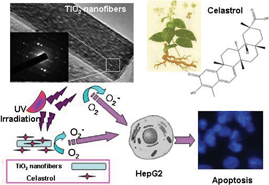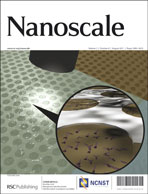As one of the best biocompatible semiconductor nanomaterials, TiO2 nanofibers can act as a good photosensitizer material and show potential application in the field of drug carriers and photodynamic therapy to cure diseases. Celastrol, one of the active components extracted from T. wilfordii Hook F., was widely used in traditional Chinese medicine for many diseases. In this study, the cytotoxicity of celastrol for HepG2 cancer cells was firstly explored. The results showed that celastrol could inhibit cancer cell proliferation in a time-dependent and dose-dependent manner, inducing apoptosis and cell cycle arrest at G2/M phase in HepG2 cells. After the TiO2 nanofibers were introduced into the system of celastrol, the cooperation effect showed that the nanocomposites between TiO2 nanofibers and celastrol could enhance the cytotoxicity of celastrol for HepG2 cells and cut down the drug consumption so as to reduce the side-effect of the related drug. Associated with the photodynamic effect, it is evident that TiO2 nanofibers could readily facilitate the potential application of the active compounds from natural products like celastrol. Turning to the advantages of nanotechnology, the combination of nanomaterials with the related monomer active compounds of promising Chinese medicine could play an important role to explore the relevant mechanism of the drug cellular interaction and promote the potential application of TiO2 nanofibers in the clinical treatment.

You have access to this article
 Please wait while we load your content...
Something went wrong. Try again?
Please wait while we load your content...
Something went wrong. Try again?


 Please wait while we load your content...
Please wait while we load your content...